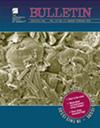东天山板块窗口上方的二叠纪-三叠纪岩浆活动:对阿尔泰山脉南部演化的影响
IF 3.7
1区 地球科学
Q1 GEOSCIENCES, MULTIDISCIPLINARY
引用次数: 0
摘要
二叠纪-三叠纪金属-高铝质花岗岩、黑云母-超基性岩块、镍-铜-金矿床是阿尔泰山南段东天山的突出特征。然而,共生花岗岩和黑云母-超基性侵入体之间的成因关系,以及岩浆作用和相关成矿作用的地球动力学仍不明确。为了解决这些模糊问题,我们对东天山双岔沟岩群的花岗岩和黄山东岩群的辉长岩进行了岩石学、地球化学和大块岩石Sr-Nd-Fe和锆石U-Pb-Hf同位素分析。锆石U-Pb年龄表明,黄山东辉长岩成岩时间约为277.8 ± 1.4 Ma。相比之下,从双岔沟花岗岩中的锆石测定的U-Pb年龄表明,双岔沟花岗岩群由三个阶段的岩浆活动结晶而成:(1)以早期片麻岩和花岗岩脉为代表的强过铝S型花岗岩岩浆(约289 Ma);(2)以早期片麻岩和花岗岩脉为代表的强过铝S型花岗岩岩浆(约289 Ma);(3)以早期片麻岩和花岗岩脉为代表的强过铝S型花岗岩岩浆(约289 Ma)。289 Ma),(2) 以中期花岗岩为代表的含金属铝至弱高铝的 I 型花岗岩岩浆(约 283-261 Ma),以及 (3) 晚期花岗岩(约 250-241 Ma)。中期和晚期花岗岩(约283-241 Ma)中轻稀土元素和大离子亲岩元素(如Rb、Th和U)明显富集,而高场强元素(如Nb、Ta和Ti)则明显贫乏,这与弧形岩浆相似,表明中三叠世时北天山洋板块仍在俯冲。考虑到岩浆岩的多样性(如洋中脊型岩浆岩、I 型、S 型和 A 型火成岩)、成矿类型(如阿拉斯加型镍铜硫化物矿床和成因型金矿床)以及发生的右旋走向滑动断层(如康古尔断层),天山北麓在三叠纪中期仍处于俯冲状态、我们认为,北天山大洋板块俯冲部分的分裂形成了板块窗口,使天体层地幔上涌并部分熔融,形成了黑云母-超黑云母侵入体及相关的镍铜硫化物矿床。岩浆的持续迁移为地壳物质的部分熔化、脱溶和脱硫提供了必要的热量,从而产生了二叠纪-三叠纪高K至钙碱性的I型和S型花岗岩以及相关的造山金矿。通过将本研究的结果与已发表的有关康古尔堆积复合体的研究成果相结合,我们认为北天山洋的俯冲可能一直持续到晚三叠世。本文章由计算机程序翻译,如有差异,请以英文原文为准。
Permian−Triassic magmatism above a slab window in the Eastern Tianshan: Implications for the evolution of the southern Altaids
Permian−Triassic metaluminous−peraluminous granitoids, mafic−ultramafic plutons, and Ni-Cu and Au deposits are prominent features in the Eastern Tianshan of the southern Altaids. However, the genetic relationship between coeval granitoids and mafic−ultramafic intrusions, and the geodynamics of magmatism and related mineralization, remain ambiguous. To address these ambiguities, we present petrological, geochemical, and bulk-rock Sr-Nd-Fe and zircon U-Pb-Hf isotope analyses of granitoids from the Shuangchagou Complex and gabbros from the Huangshandong Complex in the Eastern Tianshan. Zircon U-Pb ages demonstrate that the Huangshandong gabbro was emplaced at ca. 277.8 ± 1.4 Ma. In contrast, U-Pb ages determined from zircons in the granitic rocks of the Shuangchagou Complex suggest that the complex crystallized from three stages of magmatism: (1) strongly peraluminous S-type granitic magma represented by early-stage gneiss and granitic veins (ca. 289 Ma), (2) metaluminous to weakly peraluminous I-type granitic magmas represented by the intermediate-stage granitoids (ca. 283−261 Ma), and (3) late-stage granitoids (ca. 250−241 Ma). The intermediate- and late-stage granitoids (ca. 283−241 Ma) show clear enrichments in the light rare earth elements and large ion lithophile elements (e.g., Rb, Th, and U), and depletions in high field strength elements (e.g., Nb, Ta, and Ti), similar to arc magmas, which indicates that the North Tianshan oceanic plate was still subducting during the Middle Triassic. Considering the diversity of magmatic rocks (e.g., mid-oceanic-ridge−type mafic rocks, and I-, S- and A-type igneous rocks), mineralization styles (e.g., Alaskan-type Ni-Cu sulfide deposits and orogenic gold deposits), and the dextral strike-slip faults (e.g., Kanggur Fault) that occurred concurrently in the Eastern Tianshan during the Early Permian to Middle Triassic, we suggest that splitting of the subducted portion of the North Tianshan oceanic plate created a slab window that allowed the upwelling and partial melting of asthenospheric mantle to form the mafic−ultramafic intrusions and related Ni-Cu sulfide deposits. Sustained migration of magma provided the heat necessary to induce partial melting, devolatilization, and desulfurization of crustal materials, producing the Permian−Triassic, high-K to calc-alkaline I- and S-type granitoids, and associated orogenic gold deposits. By integrating the results of this study with published work regarding the Kanggur Accretionary Complex, we suggest that the subduction of the North Tianshan Ocean may have lasted until the Late Triassic.
求助全文
通过发布文献求助,成功后即可免费获取论文全文。
去求助
来源期刊

Geological Society of America Bulletin
地学-地球科学综合
CiteScore
9.30
自引率
8.20%
发文量
159
审稿时长
4-8 weeks
期刊介绍:
The GSA Bulletin is the Society''s premier scholarly journal, published continuously since 1890. Its first editor was William John (WJ) McGee, who was responsible for establishing much of its original style and format. Fully refereed, each bimonthly issue includes 16-20 papers focusing on the most definitive, timely, and classic-style research in all earth-science disciplines. The Bulletin welcomes most contributions that are data-rich, mature studies of broad interest (i.e., of interest to more than one sub-discipline of earth science) and of lasting, archival quality. These include (but are not limited to) studies related to tectonics, structural geology, geochemistry, geophysics, hydrogeology, marine geology, paleoclimatology, planetary geology, quaternary geology/geomorphology, sedimentary geology, stratigraphy, and volcanology. The journal is committed to further developing both the scope of its content and its international profile so that it publishes the most current earth science research that will be of wide interest to geoscientists.
 求助内容:
求助内容: 应助结果提醒方式:
应助结果提醒方式:


